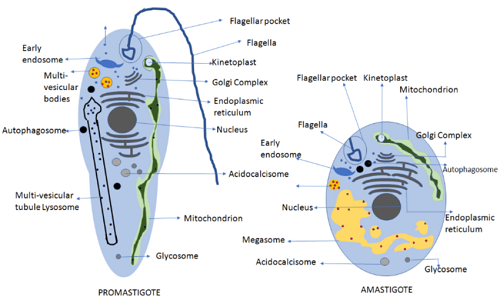Leishmania tropica complex - History, Habitat, Morphology, Culture
Introduction of Leishmania tropica complex
Leishmania tropica complex includes species such as L. tropica, L. major, and L. aethiopica which causes Old World cutaneous leishmaniasis.
Leishmania tropica is the causative agent of the classical form of Old World leishmaniasis called oriental sore or Aleppo button or Jericho boil or Delhi boil or bouton de Biskra. This condition is associated with the appearance of single or multiple localized lesions on the exposed skin which typically ulcerate and heal spontaneously.
Leishmania major causes rural cutaneous leishmaniasis.
Leishmania aethiopica causes Ethiopian cutaneous leishmaniasis.
History of Leishmania tropica complex
Historically, in 1885, Cunningham was the first person to observe the parasite in the tissue of Delhi boil and coined the name Sporozoa furunculosis.
In 1989, a Russian military surgeon Borovsky accurately described the protozoa.
Luke in 1906 gave the name Leishmania tropica while in 1911, Wenyon hinted at the role of the sandfly in the transmission of leishmaniasis.
Habitat of Leishmania tropica complex
Leishmania tropica, Leishmania major, and Leishmania aethiopica are parasites of the skin. The amastigote form habitats in humans while the promastigote form occurs in female sandflies. Unlike, Leishmania donovani, the Leishmania tropica Complex is not present in the peripheral blood or organs but is prevalent in monocytes, polymorphonuclear leucocytes as well as in the endothelial cells of the capillaries of the skin.

Figure: Leishmania tropica complex morphology (Source: ResearchGate)
Morphology of Leishmania tropica complex
The morphology of the Leishmania tropica Complex is similar to that of Leishmania donovani. The protozoa parasites exist in two forms- amastigote and promastigote form.
Amastigote form
amastigote form is found in humans and other mammal hosts
small, round to oval bodies
each amastigote form measures 2-3μm in length
resides inside monocytes, endothelial cells, polymorphonuclear leucocytes of the host
the nucleus is large and lies at a right angle to the kinetoplast which is slender, rod-shaped
axoneme arises from the kinetoplast and extends to the margin of the amastigote
vacuole, which is not stained lies alongside the axoneme
this morphological form of Leishmania tropica Complex is stained well in Giemsa and Wright stain
in Giemsa-stained preparations, the nucleus, and kinetoplast, are stained red
Promastigote
promastigote form of Leishmania tropica Complex occurs naturally in the digestive tract of sand fly (vector)
mature promastigotes are long, slender, and spindle-shaped
measures 15 μm to 25 μm in length and 1,5 μm to 3.5 μm in breadth
a single nucleus is centrally located
kinetoplast located transversally near the anterior end
the presence of a single flagellum measuring 15μm -28 μm
Leishman stain stains the cytoplasm blue, the nucleus pink, and the kinetoplast bright red
Culture of Leishmania tropica complex
The culture of Leishmania tropica Complex can be done in laboratory animals as well as artificial media.
In media
The Leishmania tropica complex can be cultured in biphasic media, liquid media, or laboratory animals. Also, Leishmania tropica is a fast grower and requires less incubation time.
Biphasic media
consists of two parts of salt agar and one part defibrinated rabbit blood
Novy and McNeal (1904) and Nicolle (1908) (NNN) medium was the first biphasic medium for the culture of Leishmania tropica complex
Liquid media
includes Schneider’s, Grace’s, and Mituhasi-Maramorosh media- which are insect cell culture media
liquid media do not contain any blood
usually used for the preparation of a large volume of promastigotes
Schneider’s medium which contains 20% fetal calf serum (FCS) is more sensitive to culture than the NNN biphasic medium
Laboratory animals
Laboratory animals such as Chinese hamsters and golden hamsters are routinely used in the culture and diagnosis of Leishmania tropica complex.